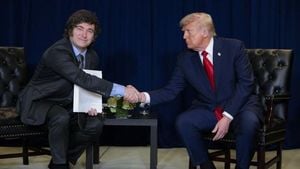On September 25, 2025, the political landscape surrounding the war in Ukraine was upended by a dramatic shift in rhetoric from U.S. President Donald Trump. In a reversal that caught both allies and opponents off guard, Trump publicly praised Ukrainian President Volodymyr Zelensky for his country’s resilience, declaring that Ukraine could reclaim all territories seized by Russia during the three-and-a-half-year conflict. This bold proclamation, delivered just days after a meeting with Zelensky, has reverberated across capitals from Washington to Warsaw, leaving analysts and world leaders scrambling to decipher its true meaning and potential consequences.
Trump’s statement was unambiguous: Kyiv, he said, "is in a position to fight and WIN all of Ukraine back in its original form." However, he was quick to clarify that this victory would depend not on the United States, but on "time, patience, and the financial support of Europe and, in particular, NATO." As reported by The Conversation, Trump made it clear that the U.S. role would be limited to supplying weapons to NATO, which would then be free to use them as it saw fit. He signed off his Truth Social message with a breezy, "Good luck to all!"—a phrase widely interpreted as a signal that the U.S. was stepping back from direct involvement and leaving the heavy lifting to Europe.
This abrupt pivot was met with surprise and, in some quarters, celebration. European leaders and Ukraine advocates welcomed the apparent show of support, while Zelensky himself expressed astonishment at Trump’s sudden U-turn. According to People’s World, Zelensky praised Trump for "understanding the realities Ukraine faces." Yet, not everyone was convinced that this newfound optimism was cause for comfort. Polish Prime Minister Donald Tusk issued a stark warning on September 25, cautioning against "illusions" about Trump’s intentions. Tusk wrote on X, "President Trump stated that Ukraine, with the support of the European Union, could reclaim its entire territory. Behind this surprising optimism lies a promise of reduced U.S. involvement and a shift of responsibility for ending the war to Europe. Better truth than illusions."
Indeed, the European response has been shaped as much by apprehension as by hope. As The Conversation noted, Trump’s shift suggests that he has "given up on a separate deal with his Russian counterpart, Vladimir Putin," and is effectively walking away from efforts to broker peace. This leaves a coalition of European and allied nations—now numbering 39, up from just eight plus the EU and NATO earlier in the year—facing the daunting task of sustaining Ukraine’s war effort without the robust American support that characterized the conflict’s early years.
The challenges are formidable. European countries are grappling with inflation, domestic spending pressures, and widely varying levels of commitment to Ukraine’s defense. Germany has taken the lead, and the EU has mobilized over €10 billion in its current budget through 2027 to supplement national efforts. Yet, as The Conversation points out, it remains unclear how long these efforts can be sustained, especially as countries like France struggle with public finances and Spain openly defies NATO’s defense spending targets.
Meanwhile, the threat from Russia has not abated. In the weeks leading up to Trump’s announcement, Russian drones twice disrupted Danish airspace near Copenhagen airport, incidents widely believed to be linked to Moscow. These provocations, combined with repeated incursions into NATO airspace, have heightened fears across the continent. German Chancellor Friedrich Merz called for "effective deterrence" by NATO, insisting, "We will not allow these attacks to continue." The alliance, for its part, warned Russia that it would employ "all necessary military and non-military tools" to defend itself.
Complicating matters further is the lack of coherence within the so-called "coalition of the willing." Its membership spans NATO and EU countries as well as Australia, New Zealand, Japan, and South Korea, but notably excludes the United States. As The Conversation highlights, the coalition’s structure is murky, with overlapping forums and unclear lines of authority. Some EU and NATO members, such as Hungary and Slovakia, have taken ambiguous stances, while others fear U.S. abandonment and are eager to placate Trump by purchasing American arms—even as this approach risks undermining the development of an independent European defense-industrial base.
In the face of these uncertainties, European leaders have called for unity and resolve. EU Commission President Ursula von der Leyen has insisted that Russia’s war of aggression "needs to end with a just and lasting peace for Ukraine." At the United Nations General Assembly, Poland’s nationalist leader Karol Nawrocki echoed Trump’s remarks, describing Russia’s invasion as "the most serious conflict in Europe since World War Two" and a "turning point" for the international order. "Russia’s aggression against Ukraine is not a purely regional conflict; it is a test of whether the principles upon which the UN is founded will stand the test of time," Nawrocki asserted.
Yet, for all the high-minded rhetoric, the path forward is fraught with risk. As People’s World observed, the U.S. strategy in Ukraine—whether under Biden or Trump—has ultimately been about weakening Russia and clearing obstacles to U.S. ambitions vis-à-vis China. The American military machine, with its global network of over 800 bases, has long sought to contain Russian influence, first through NATO expansion and then through support for successive Ukrainian governments. But the war has not gone as planned. Despite massive U.S. military aid in the early years, Russia has made slow but steady gains, and the Ukrainian army now faces the daunting prospect of reversing these advances with diminished support.
Trump’s recent description of Russia as a "paper tiger" was met with skepticism, given the country’s formidable military capabilities. As People’s World put it, "One need not be a fan of Vladimir Putin to recognize the Russian military’s capabilities." The hope among U.S. strategists that Russia would be fatally weakened, as the Soviet Union was in Afghanistan, has not materialized. Instead, the conflict has exposed the limits of Western power and the dangers of proxy warfare.
For ordinary Ukrainians, the cost has been staggering: years of suffering, death, and destruction. For Americans, the war has meant cuts to essential services and a sobering realization that the era of easy military victories is over. Trump’s oscillation—one week laying out a red carpet for Putin, the next praising Zelensky—reflects the difficult position in which U.S. policymakers now find themselves. As People’s World concluded, "Trump’s supposed change in perspective on the war... is nothing more than an excuse to wash his hands of what is, for the U.S., a losing proposition."
As Europe faces the prospect of shouldering greater responsibility for Ukraine’s defense, leaders are left to weigh the costs and risks of continued engagement. The coming months will test the resilience of alliances, the credibility of commitments, and the ability of democracies to adapt to a rapidly changing security environment. One thing is certain: the war in Ukraine, and the shifting sands of international support, will shape the future of Europe—and the world—for years to come.




